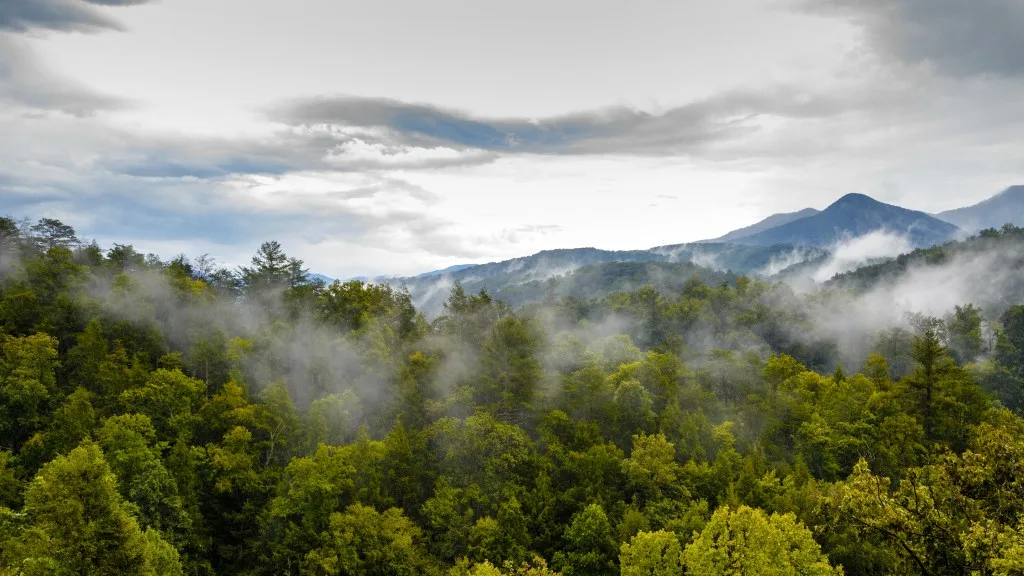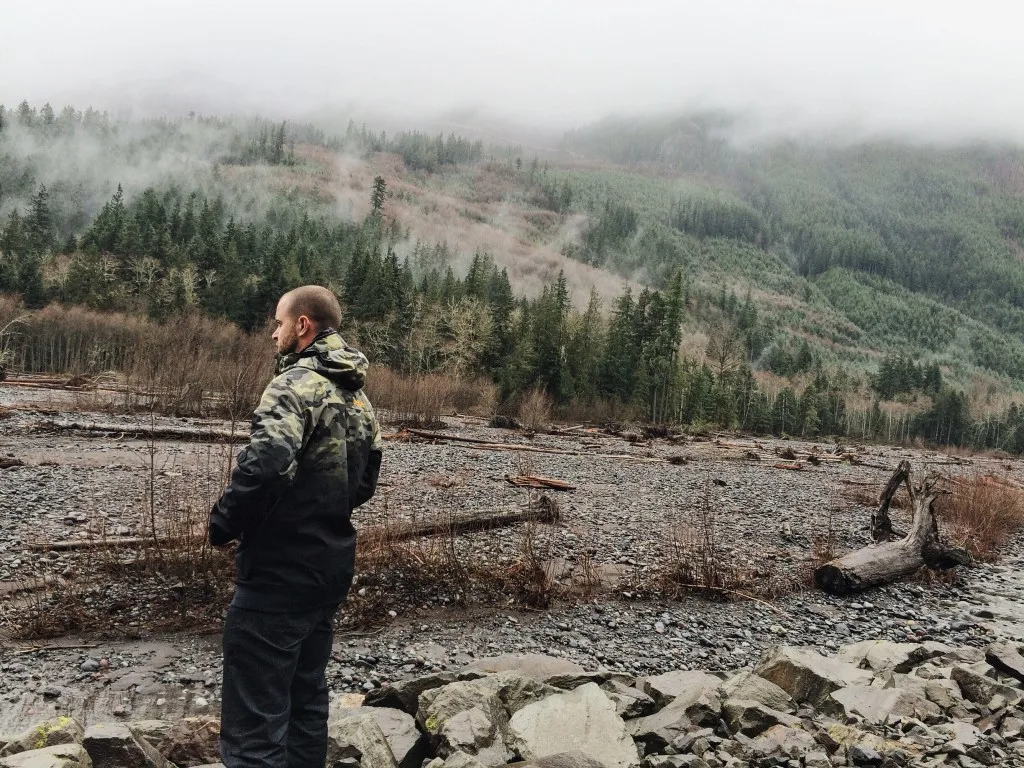The Smokies – a name that elicits distant shadowed mountains full of mystique and wonder. Great Smoky Mountains National Park similarly carries that same amazement. Shrouded in historical significance and stunning natural wonders, the Great Smoky Mountains National Park is a force to be reckoned with.
Join us as we explore the Smokies and learn why the Smoky Mountains are a national park.
About the Smoky Mountains
Nestled along the Tennessee-North Carolina border in the southeastern U.S. lies the Smoky Mountains. It’s a subrange of the Appalachian Mountains, forming a portion of the Blue Ridge Mountains. It’s 187,000 acres of forested beauty that has been around for millions of years. “Shaconage”, its original name by the Cherokee people (“place of the blue smoke”), represents the wispy blue mist that lingers.
The Smoky Mountains are full of incredible scenery, with panoramic views, cascading waterfalls, colorful wildflowers, and old-growth forests awaiting discovery. European settlers began arriving here in the 1700s, bringing advancements and conflict over the land.
History is abundant everywhere you look. While it’s a journey of epic proportions when traveling through the Smoky Mountains, it hasn’t always been an easy journey.
When Did the Smokies Become a National Park?
Many know the Smoky Mountains as the Great Smoky Mountains National Park. Today, one might think that when land becomes a national park, it’s a time to celebrate. There are times this is true. However, when the Smokies transitioned from mere mountains and forest land to a U.S. National Park, it wasn’t something everyone celebrated.
Tribal lands were prevalent here for thousands of years, then came the onset of European settlers in the 1700s. Many people considered most of the lands here personal property.
When advancements in farming and industrialization began, and natural resources dwindled some wanted preservation. Others wanted to protect their homesteads, farms, timber, and paper companies. In the late 1890s, the arduous journey of transitioning private lands into a national park began.
Supporters never waned. In May of 1926, President Calvin Coolidge signed the bill to establish it as a national park. The journey from private to protected lands finally became official in 1934 when it became a national park. Then on September 2, 1940, President Franklin Roosevelt gave his formal dedication. The journey was finally complete.

Why Are the Smoky Mountains Considered a National Park?
Two states, North Carolina and Tennessee, have joined forces to protect the Smoky Mountains, recognized as the largest swatch of upland forest east of the Mississippi. This beautiful national park means more than the fact that it’s a gorgeous landscape.
The designation as a national park also protects America’s most unique wildlife, over 1.6 million acres of U.S. Forest Service lands, and 730 miles of mountain streams and wildflowers. These natural wonders earned it an “International Biosphere Reserve” designation.
Private citizens once owned the Smoky Mountains. But many saw and understood how creating a national park could benefit the area by bringing in good roads, new jobs, and tourist spending. Thanks to their wisdom, we can still enjoy this wonder today.
Pro Tip: Spend the night at these Best Free Camping Spots Near the Smoky Mountains.
What Qualifies as a National Park?
There are many wonders throughout the U.S., and not every piece of land is considered part of the National Park Service (NPS), so what qualifies land as a U.S. National Park?
The best way to answer that is to refer to the NPS itself. “To be eligible for favorable consideration as a unit of the National Park System, an area must possess nationally significant natural, cultural, or recreational resources; be a suitable and feasible addition to the system; and require direct NPS management instead of protection by some other governmental agency or by the private sector.”
To be considered significant, a place must possess an outstanding example of a specific resource. It must also demonstrate an exceptional value in the country’s cultural themes. On top of those, it also needs to have fantastic opportunities for public recreation or scientific study. In addition, the area up for consideration as a U.S. national park must be relatively untouched and unspoiled by human impact.

Why Are the Smoky Mountains So Important?
The Smoky Mountains possess all of the above attributes, making them significant in natural, cultural, and recreational resources. They are a precious treasure of biodiversity and natural beauty. With nearly 20,000 species of plants, fungi, and wildlife, they’re home to some of the most diverse wildlife in the world.
The Smokies have been recognized by UNESCO and named a World Heritage Site and an International Biosphere Reserve – elite designations that ensure their protection and long-term conservation for future generations. These designations help to promote the region’s environmental health and natural, economic, and cultural resources.
With a good percentage of the Smokies being relatively untouched, this area is one of the rare places on the planet to experience the temperate flora here before mankind had an impact on it. Knowing all this makes it even more special to explore and experience the Smoky Mountains in person.
How Many People Visit the Great Smoky Mountains National Park Annually?
And many people realize how special this national park is, as it’s the most visited U.S. national park. Being only a day’s drive away for around half of the U.S. population, it’s easy to see why it’s the top-visited park in the nation.
There’s stunning beauty throughout the park. That includes endless mountain ranges, hundreds of miles of hiking trails, scenic drives, and camping opportunities, drawing in millions of tourists. Over 14 million tourists annually, in fact. That is triple the number of tourists visiting parks like Yellowstone and Yosemite. In fact, it’s more than Yellowstone and Yosemite combined.

What Is the Most Popular Destination in Smoky Mountain National Park?
But what really makes this park so popular? Many know Smoky Mountains National Park for its 800 miles of hiking trails, including some of the highest elevations in the Appalachian Trail. It also has impressive features, such as historic cabins, mills, barns, and cemeteries that were once private land.
But perhaps some of Smoky Mountain’s most popular attractions are its breathtaking drives and overlooks. Cades Cove is especially interesting as visitors can enjoy a car-free Wednesday during peak summer. It provides undisturbed space for hikers and bikers to freely explore the wildlife-filled mountain valley with stunning historic mills.
Another popular Smoky Mountain overlook is Newfound Gap which offers a vibrant kaleidoscope of colors and shades along with majestic mountain vistas. Lastly, Clingmans Dome stands out among Smoky Mountain’s captivating overlooks. It’s the highest point in the Great Smoky Mountains National Park, offering easy access and a 360-degree view for 100 miles.
Pro Tip: Keep an eye out for these Most Dangerous Creatures in the Smoky Mountains during your trip.
What Is the Best Time of Year to Visit The Great Smoky Mountains National Park?
Smoky Mountain National Park is a breathtaking natural wonder and a perfect place for any nature lover, no matter the time of year. However, there’s something special about visiting the Great Smoky Mountains National Park during the fall.
As the busy summer season comes to an end and children head back to school, crowds are smaller and access becomes easier. During the fall, visitors can enjoy incredible wildlife viewing opportunities and some of the best fall foliage imaginable.
Traversing the Smoky Mountains in autumn is an unforgettable experience through its endless views of majestic trees with mountainous landscapes surrounding vibrant fall colors.
Can You Drive Through The Great Smoky Mountains National Park?
And there’s no better way to experience all that the Great Smoky Mountains National Park has to offer than with a scenic drive. Home to more than 384 miles of roads, this isn’t just any drive; this is a picturesque drive destination.
The most popular drive is the Blue Ridge Parkway, a 469-mile road threading through the Appalachians that connects Shenandoah National Park in Virginia to the Great Smoky Mountains National Park in North Carolina.
Cades Cove Loop Road, Cataloochee Valley, Newfound Gap Road, Roaring Fork Motor Nature Trail and Upper Tremont Road are some of the other popular drives through the Smokies.
These routes offer stunning views and many stops along the way where visitors can discover fascinating historical sites. Driving is a great way to explore this region that deserves its status as a U.S. national park.
What are you waiting for? Start planning your trip to one of the greatest national parks.
Discover the Best Free Camping Across the USA
To be honest with you, we hate paying for camping. There are so many free campsites in America (with complete privacy).
You should give it a try!
As a matter of fact, these free campsites are yours. Every time you pay federal taxes, you’re contributing to these lands.
Become a FREE CAMPING INSIDER and join the 100,000 campers that love to score the best site!
We’ll send you the 50 Best Free Campsites in the USA (one per state). Access the list by submitting your email below: